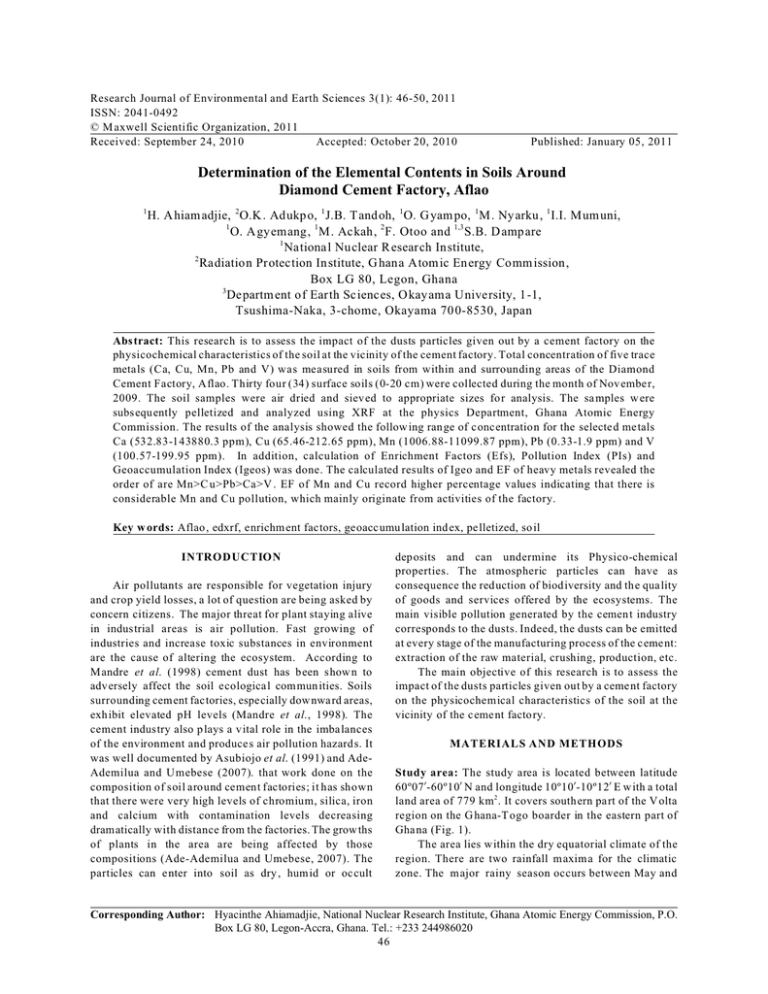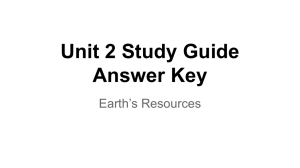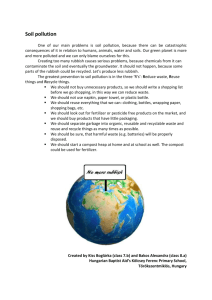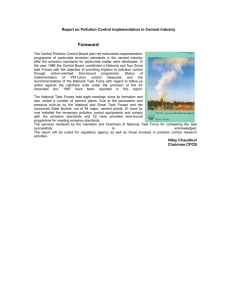Research Journal of Environmental and Earth Sciences 3(1): 46-50, 2011
advertisement

Research Journal of Environmental and Earth Sciences 3(1): 46-50, 2011 ISSN: 2041-0492 © M axwell Scientific Organization, 2011 Received: September 24, 2010 Accepted: October 20, 2010 Published: January 05, 2011 Determination of the Elemental Contents in Soils Around Diamond Cement Factory, Aflao 1 H. A hiam adjie, 2 O.K . Adukp o, 1 J.B. T andoh, 1 O. G yam po, 1 M. Nyarku, 1 I.I. Mumuni, 1 O. A gyemang, 1 M. Ackah, 2 F. Otoo and 1,3 S.B. D ampare 1 National Nuclear R esearch Institute, 2 Radiation Protection In stitute, G hana Atomic Energy Comm ission, Box LG 80, Legon, Ghana 3 Departm ent of Earth Sciences, Okayama University, 1-1, Tsushima-Naka, 3-chome, Okayama 700-8530, Japan Abstract: This research is to assess the impact of the dusts particles given out by a cement factory on the physicochemical characteristics of the soil at the vicinity of the cement factory. Total concentration of five trace metals (Ca, Cu, Mn, Pb and V) was measured in soils from within and surrounding areas of the Diamond Cement Factory, Aflao. Thirty four (34) surface soils (0-20 cm) were collected during the month of Nov embe r, 2009. The soil samples were air dried and sieved to appropriate sizes for analysis. The sa mples w ere subsequently pelletized and analyzed using XRF at the physics Department, Ghana Atomic Energy Commission. The results of the analysis showed the follow ing ran ge of concentration for the selected me tals Ca (532.83-143880.3 ppm), Cu (65.46-212.65 ppm), Mn (1006.88-11099.87 ppm), Pb (0.33-1.9 ppm) and V (100.57-199.95 ppm). In addition, calculation of Enrichment Factors (Efs), Pollution Index (PIs) and Geoaccumulation Index (Igeos) was done. The calculated results of Igeo and EF of heavy metals revealed the order of are Mn>C u>Pb>Ca>V . EF of Mn and Cu record higher percentage values indicating that there is considerable Mn and Cu pollution, which mainly originate from activities of the factory. Key w ords: Aflao , edxrf, enrichm ent factors, geoacc umu lation ind ex, pelletized, so il INTRODUCTION Air pollutants are responsible for vegetation injury and crop yield losses, a lot of question are being asked by concern citizens. The major threat for plant staying alive in industrial areas is air pollution. Fast growing of industries and increase toxic substances in environment are the cause of altering the ecosystem. According to Mandre et al. (1998) cement dust has been show n to adversely affect the soil ecologica l commun ities. Soils surrounding cement factories, especially downward areas, exhibit elevated pH levels (Mandre et al., 1998). The cement industry also p lays a v ital role in the imbalances of the environment and produce s air pollution hazards. It was well documented by Asubiojo et al. (1991) and AdeAdemilua and Umebese (2007). that work done on the composition of soil around cement factories; it has shown that there were very high levels of chromium, silica, iron and calcium with contamination levels decreasing dramatically with distance from the factories. The grow ths of plants in the area are being affected by those compositions (Ade-Ademilua and Umebese, 2007). The particles can enter into soil as dry , hum id or occult deposits and can undermine its Physico-chemical properties. The atmospheric particles can have as consequence the reduction of biod iversity and the qua lity of goods and services offered by the ecosystems. The main visible pollution generated by the cemen t industry corresponds to the dusts. Indeed, the dusts can be emitted at every stage of the manufacturing process of the ceme nt: extraction of the raw material, crushing, production, etc. The main objective of this research is to assess the impact of the dusts particles given out by a cement factory on the physicochemical characteristics of the soil at the vicinity of the ceme nt factory. MATERIALS AND METHODS Study area: The study area is located between latitude 60º07!-60º10! N and longitude 10º10!-10º12! E w ith a total land area of 779 km 2 . It covers southern pa rt of the V olta region on the G hana-T ogo boarder in the eastern part of Gha na (Fig. 1). The area lies within the dry equatorial climate of the region. There are two rainfall maxima for the climatic zone. The m ajor rainy season occurs between May and Corresponding Author: Hyacinthe Ahiamadjie, National Nuclear Research Institute, Ghana Atomic Energy Commission, P.O. Box LG 80, Legon-Accra, Ghana. Tel.: +233 244986020 46 Res. J. Environ. Earth Sci., 3(1): 46-50, 2011 Fig. 1: Location map for study area July with the peak occurring in June while the minor one occurs between September and October with the peak occurring in October (Dickson and Benneh, 2004). The mean annual rainfall generally varies between 740 and 890 mm for the dry eq uatorial climate. Mean m onthly temperature range s from 26 an d 30ºC. The m ain vegetation is coastal grassland, scrubs and man groves in the south. The soil type is mainly lateritic sandy soils, tropical black clays, tropical grey earths, sodium vleisols and coa stal sandy soils (Dickson and Benneh, 2004). The hydrogeological setting of the study area is the Recent and Tertiary formations that include unconso lidated sands and clays of lagoon, delta and littoral area, partly con solidated red continental deposits of sandy clay and gravel. It consists of a thick section of marine sands, clay, shale, limestone, sandstone and some gravel which underlie more recent sediments in the coastal area. The Recent dep osits com pris e unconsolidated sand, clay and gravels of river valleys especially along the low er Volta River, marine clays along the no rthern banks of the Keta lagoon and marine sands along the coastal littoral stretch from Aflao to Any anui, (Junner and Bates, 1945). Sampling: Thirty four (34 ) soil samples were taking randomly from different location around the Diamond Cement factory, Aflao in the month of August 2009. Each sample was taken at a depth of 0-20 cm. The samples were collected with a hand auger (a stainless steel screw) and hand spade and were placed in a clean polyethylene bags to avoid contaminations. The samples we re well labeled. Samples with ID AK1 to AK 20 were taken from the northern part of the factory, samples w ith ID C E21 to CE 26 were taken ve ry close to the Factory and samples with the ID A F 27 to A F 34 w ere taken on the southern part of the factory. Sam ple preparation: The samples were transferred to the XRF laboratory in the Physics Department of National Nuclear Research Institute. The samples w ere air dried for about 2 weeks. Each sample w as pulverized and homogenized into a very fine powder. About 500 mg of each sample were pelletized using a Specac press with a pressure of 2 tons/cm 2 to produce an intermediate thick pellet sample. The pellet produced was kept in a desiccator for at least 24 h to get rid of moisture in the sample. 47 Res. J. Environ. Earth Sci., 3(1): 46-50, 2011 Reference ma terial: Two certified standard reference soil materials SOIL-7 and GBW 07106 were similarly prepared. SOIL-7 and GBW 07106 soil standards w ere used as standard reference materials for the validation of the analytical results. Sample irradiation, counting and analysis: The elemental concentrations were determined using energy dispersive X-ray fluorescence (EDXRF). EDXRF provides a rapid and non-destructive method for the analy sis of trace and major elements in soil sam ples. A ll mea surem ents were carried out under the vacuum condition, using an X-Ray Generator (Compact 3K5) EDXRF spectrometer with a Mo target, equipped with a liquid- nitrogen-cooled Si (Li) detector. The incident and take-off angles were 45, with a Be window thickness of 12.5 mm. The distance between the sample (exposed diameter of 22 mm) and the detector was 4.5 cm. The energy resolution was 0.165 keV. We measured the concentrations of five (5) chemical elements: Namely, Ca, Cu, M n, Pb and V. In order to maximize the EDXRF sensitivities for the wide range of elements in which we were interested, two different combinations of EDXRF parame ters (including voltage and current). Applied voltage and current are varied to acquire the require K" or L" energies line. The current was adjusted to maintain similar portion s of live detection time. An ORTEC maestro multichannel analyser programme was employed for data collection. Irradiations were made for each sample, being the intermediate thick sample +target for spectrum collection life time of 1500 s. linear least squares fitting of the axil software programme was used for the spectrum deconvolution (IAEA , 2005). Emissiontransmission method in QXAS package was used to convert spectrum peak areas to concentrations T a bl e 1 : A n a ly si s o f I A E A -s o il 7 b y ED X R F Element This w ork Ca 164956±4949 Cu 10.69±0.31 Mn 635±19 Pb 60.9±2 V 64 ±1 .3 Certified values 163000±4890 11±0.33 631±18 60 ±1 .8 66 ±2 .0 T a bl e 2 : A n a ly si s o f G B W 0 7 1 06 b y E D X R F Element This w ork Ca 2165±92 Cu 20±3 Mn 149±7 Pb 8.4 ±1 .9 V 36±6 Certified values 2143±86 19±2 155±10 7.6 ±1 .2 33±4 in soil various calculations were applied (AlKhashman, 2007). In this study, geoaccumulation index (Igeo), Enrichment Factor (EF), Pollution Index (PI) and Integrated Pollution Index (IPI) were calculated to determine amount of the heavy metal contamination level in the soil. As shown in Table 3. Igeo is computed by the following equation: where, Cn represents the measured concentration of the element of interest n Bn is the background content of element n in abundance of che mical eleme nts in the continental crust. The constant 1.5 is introduced to minimize the effect of possible variations in the background values which may be attributed to lithologic variations in the sediments. The following classiWcation is given for geoaccumulation index [12] : <0 = practically unpolluted, 0-1 = unpolluted to mo derately polluted, 1-2 = moderately polluted, 2-3 = mod erately to strongly polluted, 3-4 = strongly polluted, 4-5 = strongly to extremely polluted and >5 = extrem ely polluted. The calculated results of Igeo of h eavy metals in soil in farms around the cem ent factory are presented in Table 3. The Igeo ranges from -6.8682 to 1.2087 with a mean value of -4.22 59 for Ca, -0.3338 to 1.366 with a mean value of 0.507582 for Cu, -0.5011 to 2.9615 with a mean value of 0.4216 for Mn, -1.0097 to -0.0183 with a mean value of -0.4082 for Pb an d -5.83 39 to -3 .3062 with a mean value of -4.1145 for V. The mean values of Igeo decrease in the order of Mn>Cu>Pb>Ca>V, 100% Igeo of Pb and V, 94% of C a, 12% of C u a nd 38% of Mn are within class 0 which represent practica lly unp olluted areas, For unpolluted to moderately polluted, which represent class one (1), 6% of Ca, 79% of Cu and 44% of Mn fall within class one, both 9 and 12% of Igeo were RESULTS AND DISCUSSION Validation of the analytical techniques: The results were validated using IAEA - Soil-7 and GBW 07106 Certified Refe rence Materials as sho wn in Table 1 and 2. The expe rimen tal data was compared with the certified data. Con centration, enrichment factor, pollution index and geoaccumulation index values: A summary of the results and geochemical evaluation of the selected heavy metal in the soils of the study area is presented in Table 3. The concentration of the heavy metals showed that Ca ranges from 532.83-143880.3 mg/kg, Cu 65.46-212.65 mg/kg; Mn 1006.88-11099.87 mg/kg; Pb 0.33-1.9 mg/kg and V 100.57-199.95 mg/k g, respectively. M ost of the samples analysed sh owed that the selected m etal con tents in the soil can be classified either polluted or unpolluted. To quan tify the lev els of m etals enrichm ent or pollution 48 Res. J. Environ. Earth Sci., 3(1): 46-50, 2011 Table 3: Summary of the heavy metal contents of the soils around diamond cement factory, Aflao Concentration (mg/kg) Enrichment factor Pollution index --------------------------------------------------------------------------------------------------------Range Mean Range Mean Range Mean Ca 53 2.8 3-1 43 88 0.3 14684.34 0.0018-9.0903 1.0568 0.0128-3.4670 0.3538 Cu 65.46-212.65 121.07 0.4747-11.7811 4.0376 1.1902-3.8664 2.2012 Mn 1006.88-11099.87 2223.90 0.1339-31.3983 5.1265 1.0599-11.6841 2.3409 Pb 0.3 3-1 .9 1.18 0.1842-6.4962 2.3580 0.745-1.4811 1.1585 V 100.57-199.95 156.40 0.0052-0.5777 0.1893 0.0263-0.1517 0.0940 recorded in copper and manganese respectively, these percentages were foun d to be in moderately to polluted classifications, Igeo o btained for M n reco rded strongly polluted to extremely polluted with a percentage of 6%. Enrichment Factor (EF) of an element in the studied samples was based on the standardization of a measured element against a reference element. A reference element is often the one characterized by low occurrence variability, such as the most commo nly used elements: Al, Fe, Ti, Si, Sr, K, etc., (Duzgoren-Aydin, 2007; Li et al., 2001; Sezgin et al., 2003 ). The EF calculation is expressed below as: Geoaccumulation index -----------------------------------Range Mean -6.8682 - 1.2087 -4.2259 -0.3338 - 1.366 0.50758 -0.5011 - 2.9615 0.5216 -1.0097 - -0.0183 -0.4082 -5.8339 - -3.3062 -4.2845 V in soil samples collected are deficiency to minimal enrich men t. On the other hand, maximum EF of Ca, Cu, M n and P b is higher than 5, w hic h show s that C a, Cu, Mn and Pb in soil originate from anthropog enic source s. It seems, therefore, th at EF can also be an effective too l to differen tiate a natural origin from anthropogenic sources in the study. The mean EF (1.0568, 4.0376, 5.1265 and 2.3580) and 100% EF of Pb, C a (88%), C u (15%), Mn (21%) and V (59%) indicate Ca, Cu, Mn Pb and V in the samples collected are in state of deficiency to the minimal enrichment w hile about 6% of C a, 62% of C u, 62% of Mn and 32% of V belong to moderate contamination areas. Calcium (6%), C u (24%), M n (18%) and V (9%) have EF between 5 and 20, which show the sign ificant en richm ent. Pollution index an d integrated po llution index are also commonly used to assess the environmen t quality (dos Anjos et al., 2000). The PI was deWned as the ratio of element concentration in the study to the background content of the abundance of chemical elements in the continental crust. The PI of each element was calculated and classiWed as either low (PI#1), middle (1<PI#3) or high (PI>3 ). The IPI of all measured elements for each sample was deWned as the mean value of the elemen t’s PI, and was then classiWed as low (IPI#1), middle (1< IPI#2) or high (IPI>2 ). The PIs, calculated according to the background concentration of heavy metals in Continental average crust, vary greatly across the different metals. In vanadium (0.0263-0.1517) both minimum and maximum PI values fall within the low pollution range, while in calcium (0.0128-3.4670) and lead (0.745-1.4811), the minimum PI values are within the low pollution range but the maximum values are found to be high polluted and midd le polluted classes resp ectively, both Cu (1.19023.8664) and M n (1.05 99-11.6841) are found to be within high pollution class. For arsenic and vanadium the mean PI or IPI are 0.3538 and 0.0940 respectively while Cu (2.2012) and Mn (2.3409) recorded high IPI and lead (1.1585) has its mean PI indicating contamination just above low level. The calculated means of EF, Igeo and PI of heavy metals (Ca, Cu, Mn, Pb and V) in soil samples collected are presented in Fig. 2. The mean values of EF and PI decrease in the order of Mn>C u>Pb>Ca>V , Ca, Pb, and V recorded negative Igeo which is good because there is no pollution w hile Cu and M n show some pollution levels in the so il. where, Cx is the co ncen tration of the elem ent of interest Cref is the concentration of reference element for normalization EF values less than 5.0 are not considered signiWcant, because such small enrichments may arise from differences in the co mpo sition of local soil material and reference soil used in EF c alculations (Sezgin et al., 2003). However, there is no accepted pollution ranking system or categorization of degree of pollution on the enrichment ratio and/or factor methodology. Five contamination categories are recognized on the basis of the enrichment factor: EF < 2 states deWciency to minimal enrich ment, EF = 2-5moderate enrichment, EF = 5-20 signiWcant enrichment, EF = 20-40 very high enrichment and EF > 40 extremely high enrichment (DuzgorenAydin et al., 2006; Sezgin et al., 2003). Enrichment factors of heavy metals were calculated for each soil sample relative to the background values of Abundance of chemical eleme nts in the continental crust, choosing Fe as the reference element. The EF of Ca, Cu, Mn, Pb and V is in the range of 0.0018-9.0903, 0.474711.7811, 0.1339-3 1.3983, 0.1842-6.4962 and 0.00520.5777 with a mean of 14684.34, 121.07, 2223.90, 1.18 and 156.40, respectively in Tab le 3.The mean EF of Cu, Mn and Pb is higher than 2, while the mean EF of Ca and V is less than or close to unity. On the other hand, maximum EF of V is less than two (2) which shows that 49 Res. J. Environ. Earth Sci., 3(1): 46-50, 2011 Al-Khashman, O.A., 2007. Determination of metal accumulation in deposited street dusts in Amman, Jordan. Environ. Geochem. Health, 29: 1-10. dos Anjos, M.J., R.T. Lopes, E.F.O. De Jesus, J.T. Assis, R. Cesareo and C.A.A. Barradas, 2000. Quantitative analysis of metals in soil using X-ray fluorescence, Spectrochim. Acta. B., 55: 1189-1194. Asubiojo, O.I., P.O . Aina , A.F. Oluw ole, W . Arshed, O.A. Akanle and N.M. Spyrou, 1991. Effects of cement production of the elemental composition of soils in the neighbourhood of two cement factories. W ater Air, Soil Pollut., 5758: 819-828. Dickson, K.B. and G.A. Benneh, 2004. New G eography of Ghana. Longmans Group Ltd., London. Duzgoren-Aydin, N.S., 2007. Sources and characteristics of lead pollution in the urban environment of Guangzhou, Sci. Total Environ., 385: 182-195. Duzgoren-Aydin, N.S., C.S.C. Wong, A. Aydin, Z. Song, M . You and X.D. Li, 2006. Heavy meta l contamination and distribution in the urban environment of Guangzhou, SE China, Environ. Geochem. Health, 28: 375-391. Junner, N.R. and D .A. Bates, 1945. Reports on the geology and hydrology of the coastal areas east of the Akwapim range s. Gh ana G eolog ical Survey Memo ir No. 7. Mandre, M., K. O ts, J. Rauk an d L. T uulm ets, 1998. Impacts of air pollution emitted from the cement industry on forest bioproduction. Oil Shale, 15: 353-364. Li, X., C.S. Poon and P.S. Liu, 2001. Heavy metal contamination of urban soils and street dusts in Hong Kong. Appl. Geochem., 16: 1361-1368. Sezgin, N., H.K . Ozcan, G. Demir, S. Nemlioglu and C. Bayat, 2003. Determination of heavy metal concentrations in street dusts in Istanbul E-5 highway. Environ. Int., 29: 979-985. Fig. 2: The graph of mean values of EF, PI and Igeo against Elements CONCLUSION The conc entrations of heavy metal Ca, Cu, Mn, Pb and V an d their contam ination level in soil collected from villages around Diamond Cement Factory, Aflao have been studied in the work. The concentration of Ca, Cu, Mn, Pb and V in the soil varies from 532.83 to 143880.3, 65.46 to 212.65, 1006.88 to 11099.87, 0.33 to 1.9 and 100.57 to 199.95 mg/kg, with a mean of 14684.34, 121.07, 2223.90, 1.18 and 156.40 mg/kg, respectively. The calculated results of Igeo and EF of heav y me tals reveal the order of Igeo and EF are Mn>Cu>Pb>Ca> V. EF of Mn and C u record higher percentage values indica te that there is considerable Mn and Cu pollution, which mainly originate from activities of the factory. REFERENCES Ade-Ademilua, O.E. and C.E. Umebese, 2007. The grow th of Phaseolus vulgaris L. cv. Ife Brown (Leguminosae) in a cem ent site rich in heavy metals. Pak. J. Biol. Sci., 10: 182-185. 50






